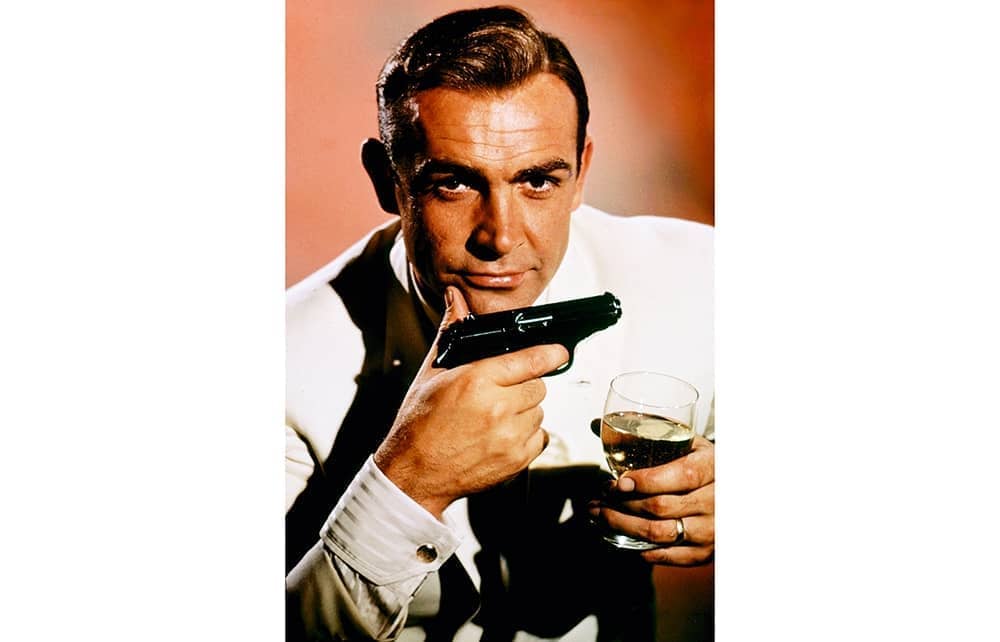‘Better use your sense,’ advised Bob Dylan: ‘take what you have gathered from coincidence.’ John Higgs is a master of taking what he can gather from coincidence – or, as he would insist, synchronicity. From the filigree of connections and echoes in the KLF (Discordianism through the lens of 1990s pop provocateurs) to the psychogeography of Watling Street to more recent deep dives into William Blake, he confronts the modern Matter of Britain: who wields power, and who resists it?
Love and Let Die starts with another perfect coincidence, namely that it was 60 years ago – to be precise, 5 October 1962 – that saw the first Beatles single appear in shops and the first James Bond film appear in cinemas. From this, Higgs conjures a whole cultural history of the past six decades, as the parallel stories of Bond and the Beatles cross over, contrast with, quarrel with and occasionally enhance each other.
From the dual release of ‘Love Me Do’ and Dr. No, the protagonists keep rubbing up against each other. Help!, the Beatles’ second film, is essentially a Bond homage. Paul McCartney resurrected a dead-in-the-water solo career with a Bond theme. Ringo Starr married Barbara Bach, The Spy Who Loved Me’s Major Anya Amasova. The agent, for his part, was snootier. ‘My dear girl,’ Bond tells Jill Masterson in Goldfinger, ‘there are some things that just aren’t done, such as drinking Dom Perignon ’53 above the temperature of 38 degrees Fahrenheit. That’s just as bad as listening to the Beatles without earmuffs.’ But, as Higgs notes, the character
knew exactly which restaurant, tailor or brand of vermouth was the finest, and always insisted on having the very best for himself. But his mastery only extends to the material world, and music, along with the emotions it generates, are [sic] immaterial. Bond no more has good taste in music than he has an understanding of empathy or intimacy.
In the Beatles and Bond, Eros and Thanatos are at war for the soul of post-war Britain
For Higgs, the Beatles represent Love: Love Me Do. She Loves You. Can’t Buy Me Love. All You Need is Love. Bond, a professional killer, represents Death: Die Another Day. Live and Let Die. No Time to Die. Eros and Thanatos are at war for the soul of post-war Britain. The contrasts are everywhere. The Beatles are northern; Bond southern. Boys like Bond; girls like the Beatles. The Beatles liked football; Bond is interested only in single-player sports. The dualities extend to minute matters of taste: the Beatles floated on a sea of tea, as anyone who has watched Get Back can attest; Bond (‘be a good girl and make me some coffee’) considered it ‘one of the main reasons for the downfall of the British Empire’.
This is a pointer to the key distinction: Bond represents a version of England that Higgs dubs the Norman Continuity Empire, the England of received pronunciation and private schooling and inherited wealth. Not only Bond, but Ian Fleming gets a rough ride from Higgs, who takes a lot of semi-aristocratic teasing perhaps too much at face value.
In his account, Fleming was a child of privilege who repeatedly failed: expelled from Eton and from Sandhurst; his role in naval intelligence ‘a cushy job handed to him by family contacts’. Jonathan Cape had to be leant on to publish Casino Royale and its first admiring reviews were all from friends. (Later, vituperative reviews were often also from friends, at least notional ones.) The novels, shot through with wish-fulfilment, were ‘rushed and barely edited’: Higgs has a particular disdain for Thunderball’s sentence ‘It was a room-shaped room with furniture-shaped furniture’, which in context is a perfectly fine example of Chandlerian laconic. The dark power of the novels is conceded through gritted teeth.
The two worlds collided most recently at the opening ceremony of the 2012 Olympics. For Higgs, the section where Daniel Craig, in character, escorted the Queen by helicopter and the two appeared to parachute down to the stadium both acknowledged the Norman Continuity Empire and defanged it. ‘Danny Boyle and Frank Cottrell-Boyce had used the banishing power of laughter to protect their ceremony from being claimed by the powers that be through mild ridicule.’ Then the stage was clear for a people’s version of Britain – the NHS, suffragettes and, inevitably, the Beatles, from giant yellow submarines to the Arctic Monkeys singing ‘Come Together’ to Paul McCartney leading a mass singalong of ‘Hey Jude’.
The Beatles and Bond remain the only two post-war UK cultural colossi with multi-generational and global reach: Higgs notes that Doctor Who (whose lead has regenerated more often even than Bond) is largely an Anglophone phenomenon and that today’s teenagers are tiring of Harry Potter. But No Time to Die was the most successful western film since the pandemic. Get Back was watercooler TV and (since the book went to press) a new deluxe edition of Revolver has been announced.
Higgs’s central thesis has an overarching explanatory power and he marshals a wide range of details. The duality may not be quite as sharp as he insists. The Kiss-Kiss is as central to Bond’s glamour as the Bang-Bang. The Beatles were no strangers to occasional cruelty and even violence (in Get Back, John jokes about having beaten and hospitalised a friend at Paul’s 21st birthday party six years earlier). And even if the lyrics celebrate love, rock music’s energy often contains a thrill of aggression. But Higgs’s final verdict, on how James Bond will return, is inarguable. ‘There is no reason why you can’t be emotionally intelligent behind the wheel of a really fast sports car.’ Indeed.






Comments